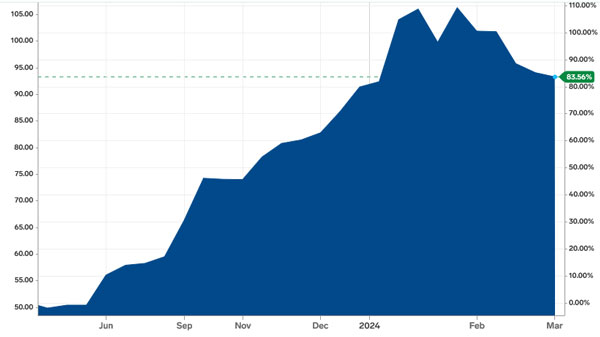This headline caught my eye last week:
|
|
|
Source: Tech Radar Pro |
The cloud computing division of Amazon – Amazon Web Services (AWS) – has just paid US$650 million to secure a nuclear-powered data centre in Pennsylvania.
This move intrigued me greatly.
As you might be aware, nuclear is a bit of a hot political topic right now, with Labor arguing against it and the Liberals pushing for a discussion on small nuclear reactors.
I suspect the politics will go with Labor on this one.
Fear campaigns usually do in Australia.
But of more interest to me is what’s happening out in the real world.
And on that front, things look a lot more positive on the nuclear front.
I mean, the uranium price has been on a tear this year bringing a bunch of uranium mining stocks with it.
|
|
|
Source: Markets Insider |
But that’s not want I want to talk about today…well, not directly.
I’m more interested in the intersection of AI and energy because I think it could be a very intriguing angle for you as an investor.
Although this was a comparatively smallish deal, the fact one of the biggest tech companies in the world is doing it at all, is a very interesting turn of events.
So why are they?
Well, here’s the thing…
AI’s big energy problem
As you know, Amazon is one of several big tech companies pushing hard into the AI space.
Their cloud division grew revenues by 13% over the course of 2023, drive mostly by an increasing interest in AI services.
They expect things to ramp up considerably in 2024 with CEO Andy Jassy saying recently:
“Gen AI is and will continue to be an area of pervasive focus and investment across Amazon, primarily because there are few initiatives if any that give us the chance to reinvent so many of our customers experiences and processes, and we believe it will ultimately drive tens of billions of dollars of revenue for Amazon over the next several years.”
Most of the big tech CEOs are saying much the same thing.
They’re all uber bullish on the potential of AI to become some sort of all-pervading part of digital life. Much like the internet did.
But here’s the problem.
AI is very energy intensive. Shockingly so.
A report in Scientific American concluded that every data centre in the world is going to:
‘…experience effectively a 10-fold increase in energy consumption. That would be a massive explosion in global electricity consumption.’
The author went on to say this was a worst-case scenario.
But worst case in his eyes was the exact types of scenarios the big CEOs like Andy Jassy at Amazon are predicting!
Which brings us to Amazon’s recent nuclear deal.
Big tech doesn’t want to be accused of driving an increase in carbon emissions and yet at the same time they need to secure clean, reliable, low-cost energy to power the AI world of the future.
And nuclear power is perfect for that. I expect to see more of this kind of thing over 2024, and that could spell an opportunity in uranium mining.
Though I should note that my tech analyst Charlie Ormond has done some work on this and thinks maybe this idea isn’t as promising as it was a year back when uranium prices were more subdued.
Still, it’s an idea we’ll continue to investigate for subscriber of our Alpha Tech Trader service.
And there’s a nice twist to this story too.
You see, it appears some scientists are using the tools of AI to accelerate technological development in the field of nuclear itself!
As the IAEE reported:
“In order to be competitive, as well as integrated into the mix of modern energy systems, nuclear power plants – in addition to being safe, secure and reliable – also need to be economical and efficient,” said Mikhail Chudakov, IAEA Deputy Director General and Head of Department of Nuclear Energy, in his welcome remarks. “AI-based approaches can contribute to these areas.”
The article here goes on to talk about AI solution for predictive maintenance, optimisations, anomaly detection and even new types of fusion technology.
There’s a nice bit of circularity here, where nuclear helps AI expand and AI helps nuclear tech improve.
But the broader point is this…
Beyond the numbers
What I find really exciting about investing in game-changing technology ideas is the sheer breadth of the opportunities they present.
But unlike a lot of investing, you don’t find such ideas by scanning financial statements.
You have to read widely, you have to understand business models, who has a competitive advantage and who doesn’t.
You also have to understand supply chains and how a new technology potentially changes them.
Think about how the internet destroyed the old model of retail shopping. Or how Netflix destroyed the video store.
There’s also the uncertainty of entropy as thing progress in ways no one yet understands or thinks possible.
All this flux, progress, and excitement throws up opportunities and risks in equal measure.
And sometimes in the most unlikely of places…I mean, who’s connecting nuclear to AI right now?
Not many people I know of…
Such asymmetric opportunities are what I live for as an investor.
That is, the chance to make many multiples of gains compared to your downside risk.
I’ve done it personally before, riding such trends as blockchain tech (I first got into Bitcoin in 2014) and the advance of electric cars (mostly by investing in lithium and battery metal miners in 2016).
I know from experience that getting in early is key to making the big money in such fast-growing areas.
But AI could be a lot, lot bigger than either of those two massive opportunities.
And my gut says, whoever can work out how this plays out over 2024, could be set up for the rest of the next decade.
Not that that’s easy to do of course.
But my colleague Callum Newman has formulated strategy.
It’s called Lock. Build. Explode. And it comes out this Thursday.
Watch this space…
Good investing,
 |
Ryan Dinse,
Editor, Crypto Capital and Alpha Tech Trader



